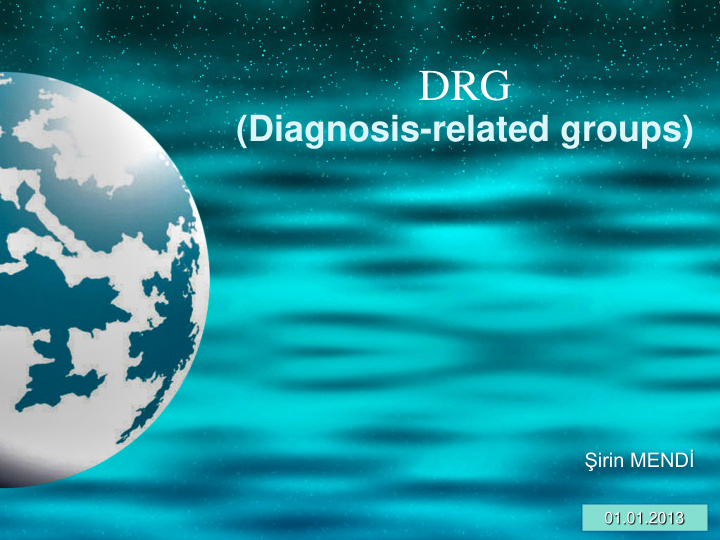



DRG (Diagnosis-related groups) Şirin MENDİ 01.01.2013
What is DRG? Diagnosis Related Groups ( DRG) is the output of a research project developed by the Yale University in the 1970’s to understand the applicability and adaptability of industrial cost and quality management methods to the hospital “industry”.
Diagnosis Related Groups (DRG) An inpatient classification method that consists of patients being grouped using thier clinical and financial data and of similar ailments being assigned to similar groups. 3
The Objective of DRG; To distribute limited resources fairly based on the types and intensities of cases To encourage the hospital’s productivity and efficiency To collect meaningful clinical data. . 4
The DRG Logic? Every patient is unique and every patient has A series of different clinical diagnoses, Risk factors, DEMOGRAPHIC DIAGNOSES DATA Family situation. We need to separate these into groups İŞLEMLER that define them with similar conditions in order to give meaning to this diversity. TİG 5
The DRG Logic? To group the patient based on the main diagnosis and then to subgroups according to the existence or lack of secondary illnesses. HYPERTENSION + DM HYPERTENSION + PREGNANCY + DM HYPERTENSION + HYPERTENSION DM HYPERTENSION HYPERTENSION 6
Coding Illnesses Coding is the expression of illnesses, injuries and procedures in numerical or alphabetical form. Example: - Acute posthemorrhagic anemia D62 - Or medicated related aplastic anemiaD61.1 7
What is ICD-10-AM? Its basic structure is comprised of ICD (International Statisticial Classification of Diseases)- 10 (WHO). The International Statistical Classification of Diseases and Related Health Complications – Australian modification . 8
What is ICD-10-AM? ICD-10-AM: Diagnoses Procedures Factors that effect state of health Symptoms, indications and abnormal clinical findings Australian coding standard 9
Countries that use DRG Australia Bulgaria Belgium USA Romania Holland France Slovenia Japan Portugal Switzerland Singapore Canada Malaysia England Thailand Ireland Costa Rico Korea Italy Iceland Taiwan Spain Norway China Germany Sweden New Zealand Hungary Denmark Other…. Czech Finland 10 Repub
Its Superiority Compared to Other Payment Systems It takes into account the severity of the illness, It can classify all admitted patients not just surgery cases, It makes it possible to compare hospitals and measure performance by means of a case combination index, It encourages cost control and productivity in hospitals, It make it possible to control pricing and budget by means of relative values calculated based on cost analyses . 11
The Data Components that are Necessary for DRG Gender ICD-10-AM Codes Main Diagnosis Hospitalization Period Additional Diagnoses Such Or Dates of Admittance- as Complications and Discharge Comorbidities Outpatient status Prosedür/ ler Patient Age Or Date of Birth Weight of newborn at admittance Reason for Discharge For 28 days and less, also for those under 2500 grams (Type of release) and for larger The National Standard contains concepts such as, “deceased-transfer, 12
DRG Formation The diagnosis, procedures and age of the patient, gender, manner of discharge, hospitalisation period, newborn weight, outpatient status, duration of stay in intensive care, mechanical ventilation period, etc. and other data. 495 ~ 16 000 ~25 DRG illness MDC* ~ 6 000 1200 procedure 13
Relative Value and Case Mix Index (CMI) Relative Value; The proportion of a DRG cost to the average cost of all DRGs. Cost data is necessary to calculate relative value! 14
The effect of coding on DRG transformation Peptic Ulcer Chronic Perforated Peptic Ulcer Main diagnosis: K27.9 Peptic ulcer, not accompained by perforation Main diagnosis: K26.5 or bleeding Peptic Ulser, Accompanied G63Z A peptic ulcer by Chronic Perforation without complications G62Z Peptic Ulcer with Relative Value: 1,01 complications Relative Value 1,25 15
The effect of coding on DRG transformation Papillary carcinomic thyroid ca patient has diabetes and hypertension. Coding: 2) C73 Thyroid ca 1) C73 Thyroid ca M8050/3 Papillary carcinoma M8050/3 Papillary carcinoma E11.72 Non insulin dependent diabetes mellitus, with insulin resistance I10 Essential (primary) DRG K64B Endocrine Diseases hypertension DRG K64A Endocrine Diseases Relative Value 0,76 cost Noncatastrophic Catastrophic Relative Value : 1,26 16
Case Mix Index (CMI) The rate (measurement of complexity) that allows us to compare the case production of one hospital with another . 17
The Advantages of Using the Case Mix Method Measurement of clinical activities Performance assessment between hospitals Financing In-hospital management tool A tool with which to start quality and use measurements Clinical and financial decisions made in hospital 18
Example; Hospital A (1,39) Hospital B (1,17) Hospital A having a higher (A cmi >B cmi) case mix index compared to Hospital B shows that it treats cases with higher relative value (complicated/complex) . 19
Payments to Hospitals Based on the DRG Model The relative value totals produced for each hospital in the relevant month is calculated. The relative value totals are calculated for all the hospitals that are in the study. The budget amount to be distributed in the relevant month will be distributed according to the relative values produced by the hospital and the Case Mix Index . 20
I n the DRG System; the following do not affect the relative values!!! The treatment of patients with long hospital stays, Increasing the number of diagnostic and therapeutic procedures, Increasing the types and amounts of consumption materials that include the medications and materials given to the patient, The coding of diagnoses and procedures that need to be coded, 21
DGR Units in Hospitals The technical unit in hospitals where data about clinical processes are, Prepared in accordance with the DRG system, Coded correctly and consistently And the task to send them to the system are carried out. 22
Thank You… 23
Recommend
More recommend